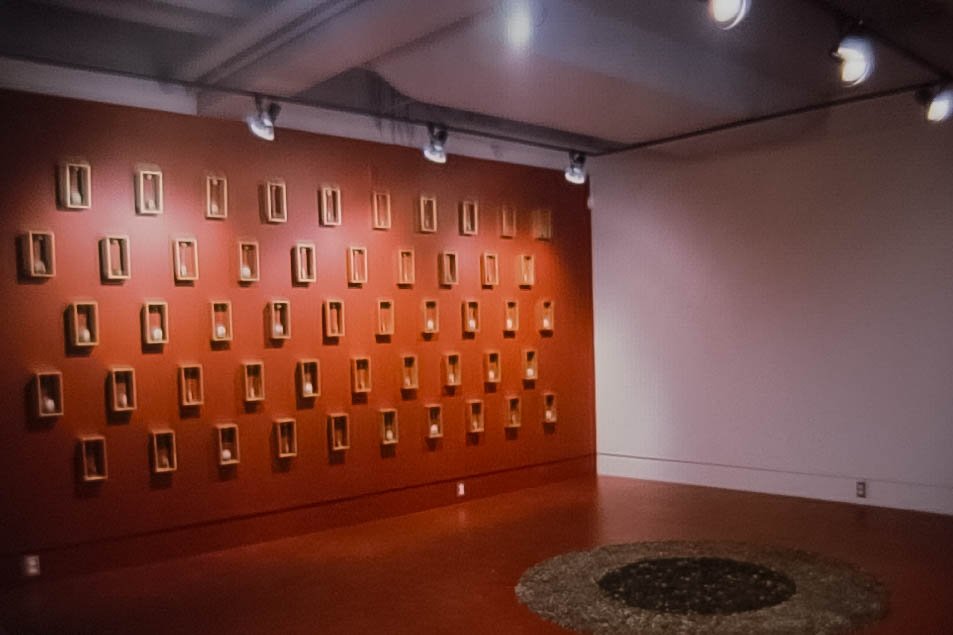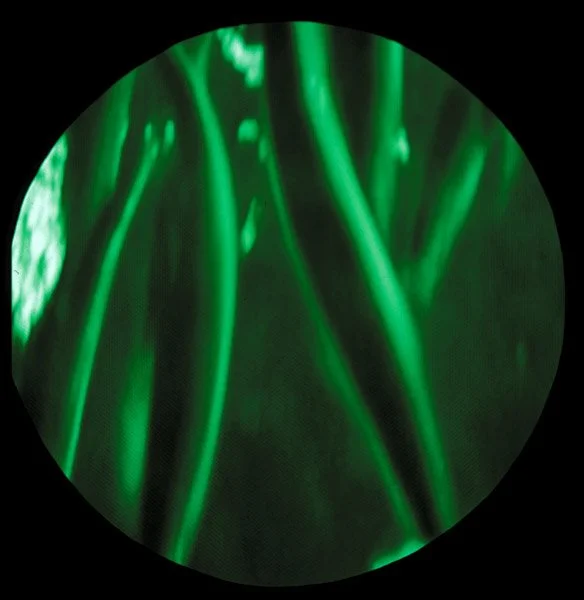
Eric Lamontagne, Luce Pelletier // Nature, Land, Laboratory: Biogenetic Landscapes
Text from the original 2003 Brochure by Portia Prigert
Quebec Artists Eric Lamontagne and Luce Pelletier consider the fast-evolving terrain between art and science. It is rich territory to explore at a time when scientists are altering conceptions of nature by creating everything from cloned sheep to square melons through genetic engineering and new reproductive technologies. the far-fetched conjectures of science fiction conjectures of science fiction a few decades ago, these new developments create both wonder and anxiety in the public. Lamontagne and Pelletier play with this uneasy fascination, questioning the limits of scientific intervention in the natural world with a whimsical humour that challenges conventional expectations.
Lamontagne uses role reversal in his work - humans become the species and are photographed, catalogued and displayed like insects in the glass cases of natural history museums. He manipulates in detail each miniature portrait according to its physical characteristics to create groupings that reference how humans reference the ways humans categorize animals. once mounted on the wall, these creatures can be viewed with a magnifying glass. Each is carefully labelled. Newborns are classified as Homo Larvae, while older specimens are Homo Chrysalids. Hairy people become Homo pilus while those wearing glasses are Homo parasites. Lamontagne calls these works “degenerate portraits” and presents each specimen with closed eyes to give the impression of artificial hibernation. In another twist, the artist houses crickets in small boxes, ostensibly as a portable interpretive audio guide to the exhibition.
Lamontagne is also interested in how animals see and has translated scientific research on vision via the medium of photography using different lenses, lights, angles and filters. Ants, for instance, cannot. Cats have remarkable vision in near darkness but see colour with less intensity than people. for each specifies, Lamontagne poses in a white lab coat in the guise of a ‘crazy scientist’ and photographs himself as he imagines the animal might see him.
For her part, Pellitier references debates over genetically modified foods and cloning, creating biomorphic fantasies, hand-made consumer products and altered agricultural landscapes. “I question science and the received wisdom upon which we base our knowledge of life,” says Pelletier. “I also question our relationship with particular objects, their familiarity and banality. I choose everyday objects to awaken curiosity and encourage new ways of looking at them.” In this exhibition, she juxtaposes photographs of a pumpkin field at various stages of the growing season with the fruit of a strange harvest - shoes and boots that appear as if sculpted from the epicarp of pumpkins.
There is an unreal quality to these items, which are made from mixed media materials and resemble pumpkins. Yet, just as they are something entirely different. They are magical as if they have materialized from a fairy tale with an unimagined history all their own. Pellitier hopes her work prompts viewers to question modern agricultural practices which have become, in her words, “dubious science” in the age of genetic engineering.
Portia Priegert was a director of the Alternator Gallery of Contemporary Art.
Eric Lamontagne has a Bachelor in Fine Arts from Concordia University in Montreal and a Bachelor’s degree in education from the University of Quebec in Montreal. He has solo exhibitions in Montreal, Tokyo and throughout Quebec and has participated in group exhibitions in Japan, Belgium, Holland and Quebec. He lives in Montreal.
check out his website here.
Lucy Pelletier’s Bio:
Our relationship with nature is dependent on the conjunction of individual perspectives, centuries of experience, contemporary thought. Nowadays, one cannot think about the wilderness without also thinking about its conservation; one cannot consider agriculture without also recalling industrialization and its consequences. One can no longer talk of beauty without suspecting illusion, genetic modification, domestication.
My work is inspired by these contradictory perceptions. I create hybrid objects which inspire a fresh view of the natural world. In so doing I try to update our perception of nature so that we accept the urgent need for a reconciliation between mankind and the other kingdoms with which we share our universe, as well as for a greater acceptance of our shared accountability.
The equilibrium of our ecosystems depends on this harmonious cohabitation between living things. I propose an intimate look at living that asks us to sixteen our shared future.
Check out Luce’s website here.













